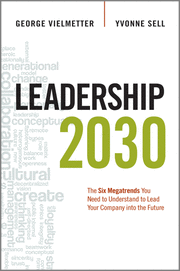Inventions, Innovations, and the resulting changes in consumer behavior constantly affect the global business environment. In our hyper-connected world, social and demographic changes in different continents shape how consumption will change in the next few years or later. Only businesses that are able to spot these changes and accurately predict the impact on the business environment can sustain and outlive the changes in the coming decades.
The question is, are all changes and fads worth the attention of business leaders and does every deviation warrant the attention and analysis required to keep businesses in the lead. Maybe not, but megatrends do.
In Leadership 2030, the authors explain what separates a megatrend from a fad and discuss the six emerging trends that will shape businesses in the next two decades. George VielMetter has been advising and coaching CEOs, boards, and senior leaders on how leadership and human capital improves the performance of organizations for over fifteen year. He is currently director – Leadership and Talent Practice, Europe at the Hay Group. Yvonne Sell is director, Leadership and Talent–UK & Ireland, for Hay Group.
Leadership 2030: The Six Megatrends You Need to Understand to Lead Your Company into the Future
Authors: George VielMetter, Yvonne Sell
Publisher: AMACOM (6 Feb 2014)
ISBN-10: 0814432751
Book Review
Globalization is not new. We had empires fighting over trade all of the nineteenth century. By late twentieth century, trade was flourishing. The most important highlight of this phenomenon was outsourcing of manufacturing to low-cost countries. In Lost In Translation: Globalization 2.0, the authors claim that the second wave is here and will disrupt all the set ideas of global trade and money flow. The authors discuss specific changes and reasons behind these changes. They also give you examples of how things are changing with help of short, one-page case studies.
Each chapter begins with a summary of small trends that shape the megatrend the authors explore in the chapter. Here, the authors also outline the most important questions that business leaders should ask themselves in context of these changes.
Globalization has not only facilitated movement of goods. People movement and rising prosperity along with Internet penetration has also increased individualization in developing nations. Business leaders will need to take into account these changing attitudes to market products and create the right work environment.
The book mainly outlines six megatrends that the authors believe will shape the new global business environment: a new form of globalization, the global warming threat, changing attitudes of the global population, Internet penetration to remote locations, young, rising Asian population, and convergence of cross-disciplinary innovations.
Chapter 7, Reinforcers, Dilemmas, and the Perfect Storm, forces the readers to look at all the megatrends that the authors have discussed earlier not as independent events, but as forces marching together toward a common destination. The megatrends will open new opportunities, but they will also throw new challenges. For example, the authors point out that increased globalization will mean increased mobility, but this will directly be in conflict with fast depleting natural resources and the impending environment degradation.
Leadership 2030 looks at the most significant technology breakthroughs of the twentieth century and analyzes its impact on the twenty-first century. Along with these major changes in the business environment, the authors also discuss the influence these changes will have on the leadership styles.

